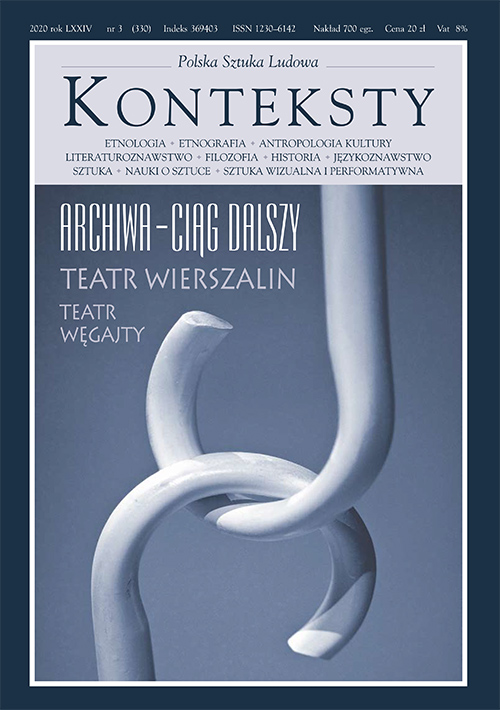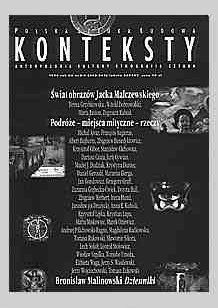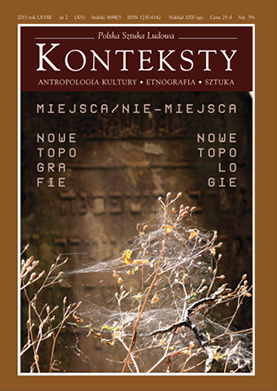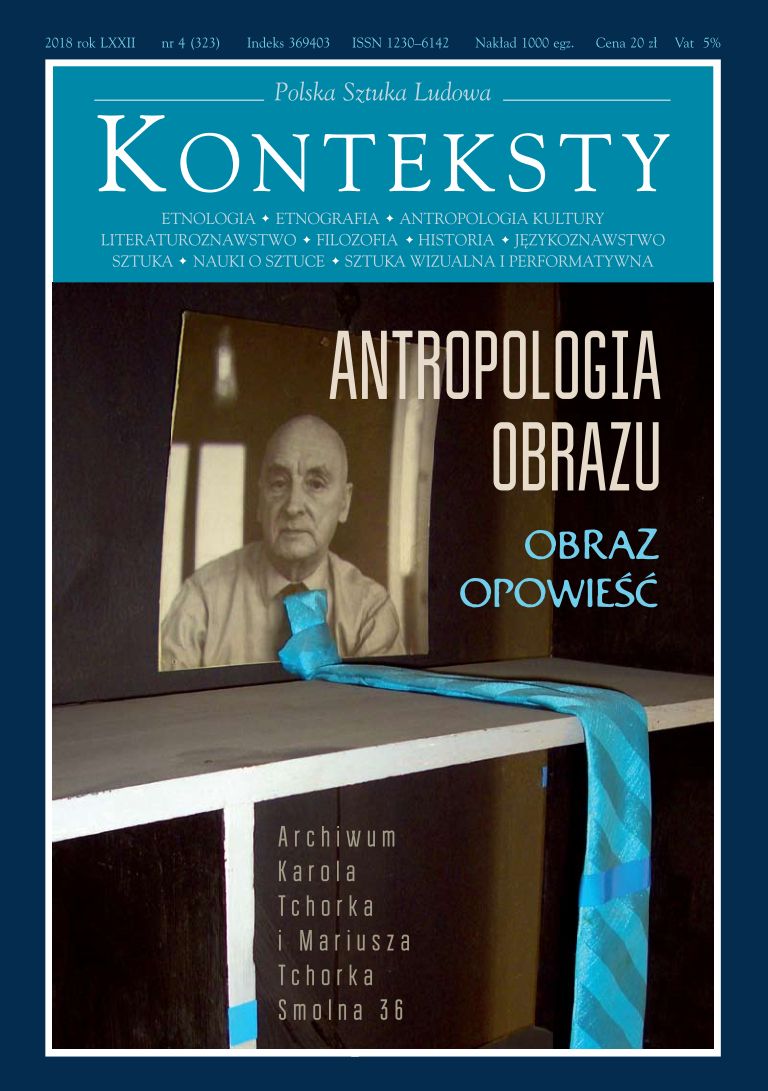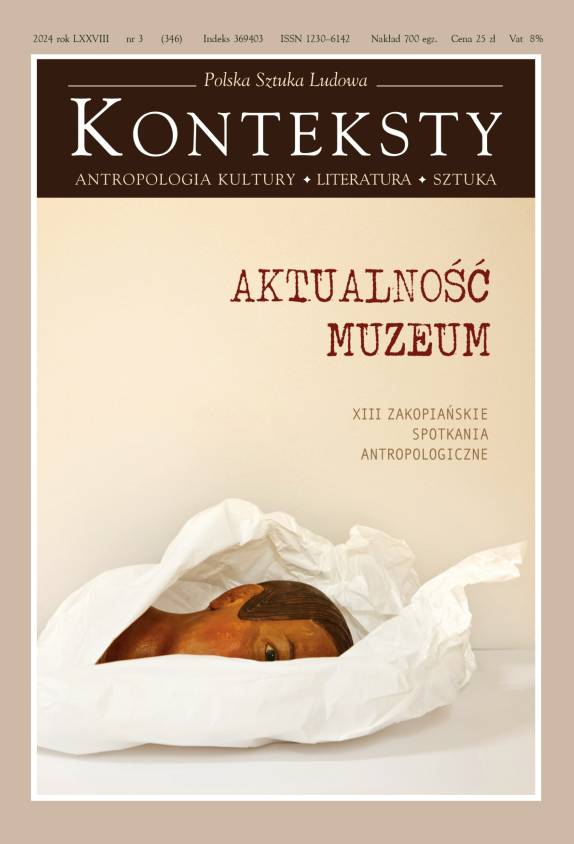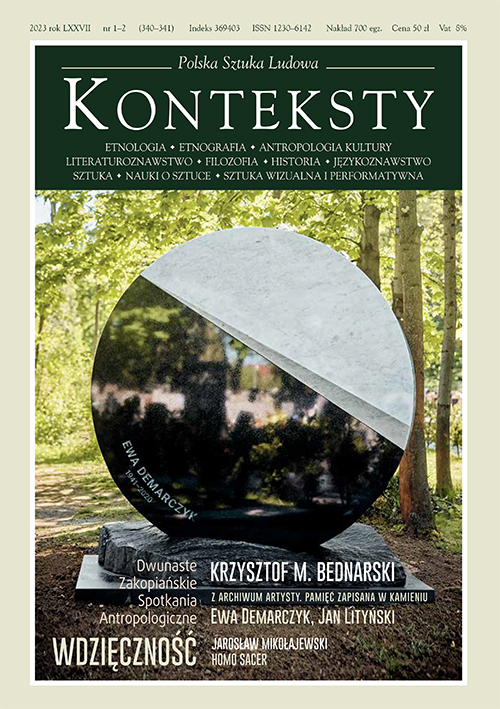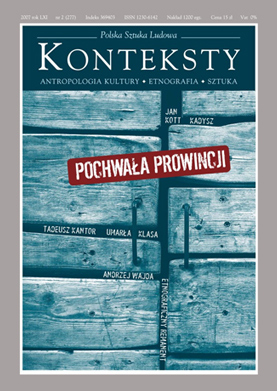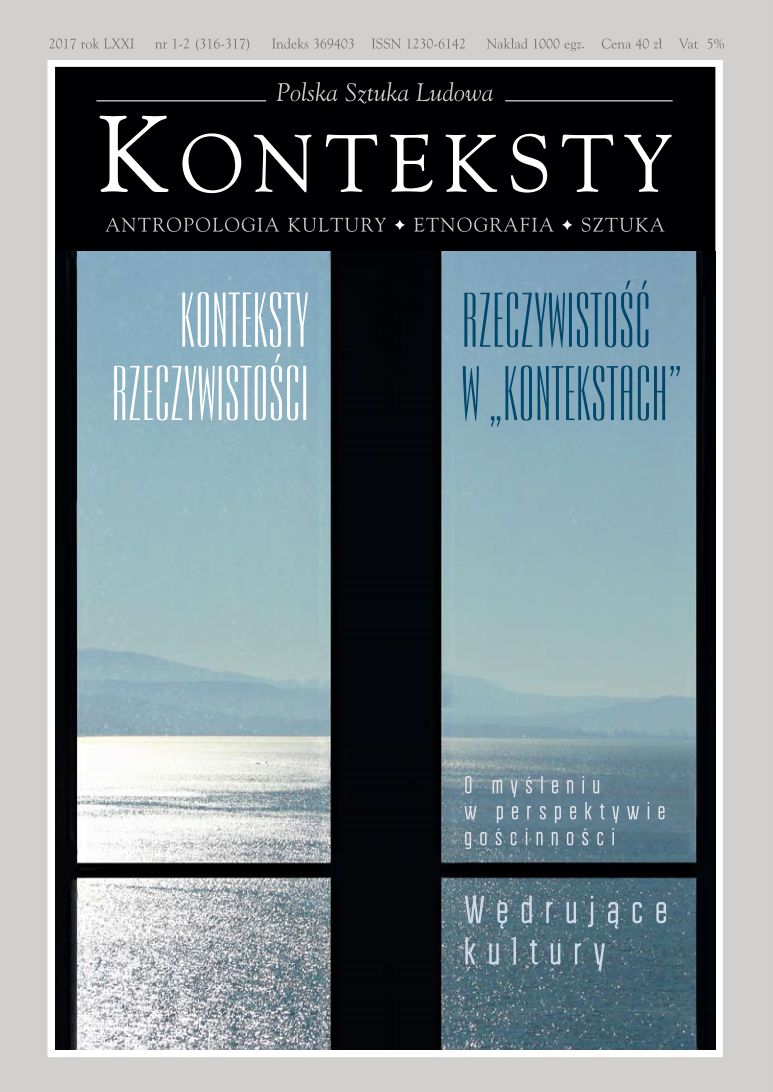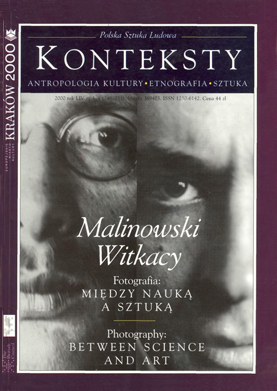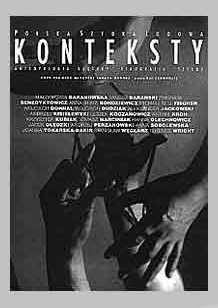Issue 2009/1-2 (284-285) -

| Ludwik Stomma | The National Character  | 3 |
The author of the presented essay continues his reflections on the phenomenon and nature of the so-called national character, a descriptive category typical for the social sciences. By referring to Portret obcego (Portrait of a Stranger) by Z. Benedyktowicz and its remark about the dynamic nature of the "one’s own kind – the outsider" category, the author draws attention predominantly to the dynamic of stereotypical images and their purely conventional status. Alluding to vast empirical material, the study underlines chiefly the purely contextual (historical) aspect of the emergence of national stereotypes, and thus opposes all those conceptions which wish to see in the “national character” a social reality determined psychologically, biologically or geographically. | ||
| Justyna Chmielewska | Istanbul: Recollections from a Lost City  | 13 |
In his recently published autobiographical book: Istanbul: Memories and the City, Orhan Pamuk attempts to present a highly personal attitude to his birthplace where he spent a major part of his life. He seeks traces of Istanbul – as he would like to see it and remember it from his childhood – in texts, images and his own slightly enhanced experiences; in its present-day form the town appears to be nondescript, unworthy of attention and dilapidated. Istanbul is a journey to the past and a non-extant city, which, nonetheless, evokes a specific variety of Pamuk’s favourite melancholy. It is a voyage amidst dusty stories by nineteenth-century authors-Orientalists and illustrations showing hills overgrown with cypresses. Finally, it is journey to a lost town – seized and overrun by successive tides of immigrants from the provinces, cultural aliens who, Pamuk seems to suggest, invaded his space, producing a specifically Istanbulian paradoxical feeling of a loss. | ||
| Jane Kilby, Graeme Gilloch | Trauma and Memory in the City: From Auster to Austerlitz  | 20 |
The published text is a translation of a chapter from Urban Memory: History and Amnesia in the Modern City, edited by M. Crinson. The authors followed the literary depiction of the theme of memory and trauma envisaged as experiences comprising part of existence in urban spaces, i. a. in texts by W.G. Sebald, S. Kracauer, W. Benjamin and P. Auster. | ||
| Adrian Forty | Concrete and Memory  | 29 |
The text, which comes from Urban Memory: History and Amnesia in the Modern City, edited by M. Crimson, is an attempt at analysing the relations between the use of concrete as a building material with memory conceived as the space of cultural and political negotiation. Taking into consideration a number of celebrated monuments the author tries to show the discussion surrounding them and the ambivalence of employing this specific material for commemorating traumatic events from the past. | ||
| Ewa Klekot | The Non-remembrance of the Ghetto  | 42 |
All the accounts presented by guides showing Warsaw to assorted visitors contain a considerable dose of martyrology: much is said about violence. The material reality of the Muranów district, however, entails non-remembrance. The original project launched by Lachert was to recall violence, but its ideological premises, which compelled people to inhabit grey housing estates made out of rubble-concrete, were rapidly tamed so that it became possible to forget. Oxygenator, realized in the summer of 2007 by Joanna Rajkowska, countered the project of a monument commemorating the victims of the Volhynian Massacre, immersed in a plebeian aesthetic of the macabresque and emotions straight out of a horror movie. What does ”restoring memory” to Warsaw and Muranów actually denote? Does it signify a mere process of bringing up to date the narration of a non-existent town, and of including into the memory of the Second World War motifs which for many years remained outside the official discourse? The answer is: yes, or even: above all else. This, however, also means a restoration of the memory of the residents of post-war Muranów – in other words, understanding the phenomenon of non-remembrance. | ||
| Zygmunt Krzyżanowski | Moscow Shop Signs  | 47 |
One of the few published sketches by Zygmunt Krzyżanowski (“30 dniey” 1925, no. 3) is a pioneering semiotic- stylistic analysis of pre-Revolutionary advertisements and “street texts” in a large city, preceding Walter Benjamin’s One-way Street by a decade. | ||
| Jan Gondowicz | Ilf’s Two Days in Warsaw  | 52 |
A fragment, selected and commented on by Jan Gondowicz, of the diaries kept by the Ilya Ilf, the author of Twelve Chairs and Golden Calf, describing two days spent in Warsaw in September 1935. | ||
| Miron Białoszewski | Chamowo  | 54 |
A fragment of Chamowo, a book by Miron Białoszewski (1975), prepared by the author for publication but never issued. | ||
| Tadeusz Sobolewski | A Date with Reality  | 56 |
Miron Białoszewski regarded unpretentious urban and suburban reality, such as the one in Chamowo, in back of the Saska Kępa district of Warsaw with access to the “groves over the Vistula”, as a living spectacle which inspired him and which he co-created. He went on evening dates with this reality, at times dictating its appearance by obliterating the boundaries between art and nature. | ||
| Marek Nowakowski | Guardian of Memory  | 59 |
A literary colourful tale, one of the stories told by the author about the Praga district of Warsaw and its inhabitants. | ||
| Sławomir Popowski | Reservation Praga  | 60 |
<span style="\"font-family:" sylfaen,serif\"="" lang="\"EN-US\"">The author discusses the myth of the Praga district in Warsaw, and mentions fashionable publications and photographic albums promoting a nostalgic approach to this part of town. With this often naïve and simplifying description as his point of departure he goes on to propose a narration about the places and events comprising a contemporary image of Praga, based on his own biography. The author does not evade nostalgia and enchantment with Praga, but at the same time he robs the portrait of all illusions of romantic idealisations. The text depicts the life of the bazaars, drinking dens, and streets of old right-bank Warsaw, together with its brutality, poverty and polluted rawness; nonetheless, the author remains capable of delighting in the beauty of a world that is no more. | ||
| Jerzy Biernacki | The Praga Family of Man  | 70 |
Jacek Sielski took photographs of the Praga district in Warsaw from a specific angle, seeking a sui generis urban folklore or encountering it frame after frame. Looking at the bodies and faces of people from the streets of Praga: Brzeska, Ząbkowska, Kawęczyńska, Stalowa and Szwedzka, or the Różycki Bazaar we suddenly see much more, and their dialogues, thoughts and experiences become “visible”. We discover not only the folklore of the people of Praga but become aware of the fact that we are facing a “Praga family of man”. | ||
| Jacek Sielski | Praga District – 1970-80 | 71 |
| Andrzej Łojko | A Praga Ballade  | 81 |
Andrzej Łojko, a photographer working in the Warsaw district of Praga, discusses the works of Jacek Sielski – a press photographer documenting the life of the district from the 1970s on. “Just as old love is recalled fondly even if it never had a happy end, so the photographs by Jacek Sielski, in the manner of an old ballad, lead us along the streets and lanes of Praga, producing tears of nostalgia”, wrote the author, recalling the long lost world of his youth. | ||
| Paweł Elsztein | The Archive of a Press Photographer  | 82 |
“I spent several weeks gazing at the presented photographs. Obviously, someone might be inclined to describe them as ordinary. But the uniqueness of these small photos produce an awareness of the significance of the work performed by Jacek Sielski, artist and excellent press photographer. (...) Jacek Sielski is familiar with the Praga district. In this case, he chose as his leitmotif a single street with an adjoining area, namely, Brzeska Street and the Różycki Bazaar. In doing so, he demonstrated, to put it in plain terms, a lot of courage. Not all the residents of Brzeska Street were willing to pose for a photographer. (...) The photos were taken in the 1970s, the difficult years of the People’s Republic of Poland. (...) The proverbial stench and filth discernible in the photographs, the highly suspicious looking men and woman, and the omnipresent poverty are the symbols of those bad old days. It was also then that Brzeska Street became known as a ‘mean street’, dangerous, and full of thugs and prostitutes, an image which Jacek Sielski captured perfectly. Looking at his photos let us keep in mind that this is an image of a past epoch and inimitable situations, similar to those captured in the now rapidly vanishing Różycki market”.
| ||
| Roman Woźniak, Grzegorz Kowalski, Zbigniew Benedyktowicz | Between Praga and Próżna Street – a Conversation about the Praga District and its Artists  | 83 |
A record of a conversation held with Grzegorz Kowalski – artist, professor at the Academy of Fine Arts in Warsaw, co-organiser of the celebrated inter-generation exhibitions held in the Praga district in the 1990s, and Roman Woźniak – director of Teatr Academia, organiser of a Praga event known as ”Neighbours for Neighbours”, and leader of the Praga art milieus. The conversation is not only a reflection about the presence of artists in Praga and the changes which took place in the district in recent years but also an attempt at reconstructing successive exhibitions featured there. | ||
| Andrzej Łojko | “Neighbours for Neighbours”  | 94 |
This text accompanied Sąsiedzi (Neighbours), an exhibition of photographs by Andrzej Łojko, shown as part of the “Neighbours for neighbours” show, describing the milieu of artists representing assorted disciplines and working in Praga (especially in 3 Inżynierska Street). | ||
| Dorota Sidorek | The Różycki Bazaar. The Myth of the Marketplace in an Anthropological Interpretation  | 106 |
A study about one of the oldest working open air markets in Warsaw, whose years-long existence exerted a certain impact on its character and, first and foremost, on its conspicuous mythologisation. The author tried to characterise the specificity of the site and the factors creating the myth, and to describe the life of the bazaar (commerce, gambling) upon the basis of the reminiscences of the residents and habitués of the Praga district as well as the stall keepers. She also embarked upon an attempt at tackling the question of the “Warsaw quality” preserved especially in the market, and asks about the reasons for narrowing it down to the described quarter. Finally, the text considers the impact of the systemic transformation upon the future of marketplaces (including trade on the Stadion Dziesięciolecia – the 10th Anniversary Stadium). | ||
| Andrzej Paczkowski, Tadeusz Olszański, Norman Davies, Janina Paradowska | „Jarmark Europa” – a Conversation  | 131 |
A registered discussion about Stadion X-lecia (the 10th Anniversary Stadium), the “Jarmark Europa” market and a symbolic boundary between the East and the West, held on 12 December 2007 at the Powszechny Theatre in Warsaw. | ||
| Roch Sulima | Stadion Bazar  | 135 |
The Warsaw open-air market in the “abandoned” Tenth Anniversary Sports Stadium is described as a cognitive figure of essential diagnostic value and not as an ethnographic oddity. According to the accepted interpretation, Stadion Bazar (the Stadium Bazaar) is a figure not of a relic, vanishing after the closure of the almost twenty-years old Europe Fair (Jarmark Europa), but of that which is emerging and anticipated in the form of intensifying trans-cultural processes. Stadion Bazar is a Polish localization of the well-known “ethno-landscapes” by Arjun Appadurai, a sui generis laboratory of the forms and styles of Polish postmodernity. An important part is played by a recognition of the “borderland syndrome” (the frontier between the East and the West) and the “revolutionary” role (in relation to the central systems) performed by an informal and, simultaneously, powerful “parallel economy” conducted in the open-air stalls of the bazaar. The author analyses the cultural consequences of the presence of Stadion Bazar in a capital city, and its influence on the transformations of the semantics of urban space and the dynamics of the styles of Polish pop-culture and consumption models. | ||
| Alexandre Bruni | The East Warsaw Tower of Babel. “Jarmark Europa”, or Where Africa Meets Asia  | 150 |
For several years Stadion X-lecia (the 10th Anniversary Stadium) in Warsaw was the site of an enormous market (“Jarmark Europa”), with traders from Asia, Africa and East Europe representing different nationalities, languages, religions and customs. The author discusses primarily two groups of the “protagonists”: the Vietnamese and the Africans, and upon the basis of observations and conversations proposes a “thick description” of the examined phenomenon. | ||
| Ignacy Strączek | Trade at the Very End  | 160 |
“In the past, the very core of the Stadium was the top tier, where the most attractive commodities were sold, and which produced the urban legends and myths that sustained the daily press. When on 30 September 2007 the top tier was closed, the traders moved to the ‘Aeroplane’, a sandy square between trams tracks and a bus station. After the announcement of the construction of a National Stadium, only rubbish remained in the terrain facing Waszyngtona Square, and the area along Grochowska and Zieleniecka streets became a dense network of stalls. The outcome assumed an interesting form of high, linked constrictions made out of brown-grey pressed metal and metal sheet, with plastic foil and canvas carefully attached to this skeleton. Every day, this structure offered commodities, which filled assorted gaps and eliminated shortages. (…) The Stadium has already experienced several agonies. Perhaps one should define its death as a process? One thing iscertain: no one is capable of halting it”. | ||
| Joanna Warsza | Stadion X – a Place that Never Existed. On Performative Projects within the Space of the 10th Anniversary Stadium  | 166 |
Stadion X-lecia (the 10th Anniversary Stadium) was erected in 1955 with the wartime rubble of the destroyed capital. For forty years its purpose was to protect the good name of communism, but paradoxically the best known events from that period was the tragic self-immolation of Ryszard Siwiec in 1968, the papal Mass celebrated in 1983, and the concert given by Stevie Wonder in 1989. In the mid-1980s it ceased fulfilling sports functions, slowly turned into a ruin, and became a post-communist phantom. During the 1990s it was “enlivened” by the Vietnamese intelligentsia and Russian traders – the pioneers of capitalism, who placed on the top tier of the Stadium camp beds full of commodities. Suddenly, the “Jarmark Europa” market proved to be the only multi-cultural place in town, a storehouse of biographies, appliances, and history, as well as one of the greatest tourist attractions. A place which theoretically did not exist could be interpreted in numerous, often contradictory, ways: as an Asian suburb, a wild forest, a kingdom of the provisional, controlled chaos and cheap shopping, a declining sports club, a ruin of socialist realistic architecture, an archaeological site suitable for field work conducted by botanists, a seat of Jehovah’s Witnesses, and many others. Performative projects within the space of the Stadium and the market emerged in response to the heterogeneous character of the site, its years-long (non-) presence in the middle of a post-communist city, and the invisibility of the Vietnamese minority. A Journey to Asia – an Acoustic Walk in the Vietnamese Sector of the 10th Anniversary Stadium (2006) and six other actions in the 2007/2008 season (Boniek!, A Scene-of-crime Inspection, The Liquidation of “Jarmark Europa”, Radio Stadium Calling, Truncheoning and Schengen) were subjective expeditions made by artists, sportsmen and activists to the reality of the “already non-existent” Stadium, but also indicated its controversial existence. Participation and para-documentary projects (a stroll, a sports match, a spectacle given on a construction site, an exhibition featuring live people) considered questions of memory, degradation, the force of the imagination, ambiguity, and the future or the challenging exotic qualities of the site. | ||
| Tomasz Szerszeń | Entropy and Architecture. The Written Stadium  | 172 |
Stadion X-lecia (the 10th Anniversary Stadium) is no longer, and its sole trace is a hole in the ground…This text, a commentary to the book Stadion X: Miejsce, którego nie było (ed. J. Warsza), delves into the symbolic presence/absence of the Stadium in an attempt at conceptualising the tension between its modernist, monumental architecture and disintegration (which could be perceived as a form of entropy – a phenomenon which stirred the interest of artists [R. Smithson] and philosophers [G. Bataille]). | ||
| Agata Chełstowska | Nutritious Difference. The Warsaw District of Praga and aGame Played in the Field of Art  | 174 |
The intention of this article is to analyse accounts by artists working in the Praga district and concerning this part of Warsaw. The titular artists ascribe to Praga a number of positive values, including authenticity and a “conducive ambiance”. The author portrays the prime protagonists of the Prague “colonisation”, their relations with the original residents of Praga, the dynamically developing “Neighbours for neighbours’” festival, and a local artistic venue – Skład Butelek. By referring to the theory expounded by Pierre Bourdieu, A. Chełstowska demonstrates that Praga is becoming part of the game played by artists. She perceives the changes taking place in the district within the context of a global history of the emergence of art quarters in large cities. Moreover, she analyses the myth of the art quarter and Bohemia (her understanding of the myth is the same as Roland Barthes’ conception of contemporary mythicality). Finally, the study describes a number of reflections about the value of authenticity and the similarities between the part played in culture by the artist and the ethnologist. | ||
| Katarzyna Kuzko | Warszawska Praga. A Scattered Self-portrait  | 185 |
This text is an abbreviated version of a licentiate dissertation written in 2006 after two years of research carried out under Dr. Anna Kuczyńska in the Institute of Ethnology and Cultural Anthropology at Warsaw University. It is also an attempt at portraying the often complicated relations between Praga and its inhabitants (or rather, the assorted visions of Praga cultivated by its residents and other participants of the processes transpiring in this district). The study contains theoretical deliberations on the identity of a place and a nostalgic view of the world which, in the author’s opinion, comprises, and continues to do so, an essential component of the image of this part of Warsaw. | ||
| Magdalena Majchrzak | The Student’s Dormitory in Kickiego Street  | 195 |
The purpose of this article is to outline an anthropological portrait of the Warsaw University Students’ Dormitory no. 3 in 9/12 Kickiego Street – a place which in the course of its fifty years-long existence has become surrounded with numerous “urban legends” and for many residents of Warsaw has made a permanent and indelible imprint on the map of the town. One of the elements of the Dormitory’s real or imaginary exceptionality is its location on the right bank of the Vistula, in the very heart of Grochów, traditionally regarded as a workers’ district, whose social label clearly differed from the one ascribed to the future “elite of the nation”, i.e. the students. The prime object of the author’s interest are the eventual developments along the meeting point of those two communities, and the manner in which the Dormitory in Kickiego Street has for years remained a fragment of the space of the Praga South district. The point of departure for the ensuing analysis are the categories of “homelessness” and liminality in reference to the status of a student – mutually compatible albeit formulated by two different authors. The first part of the article concentrates on the traces of the presence of these categories in different spheres of collective life. The following part tries to indicate certain focal points which concentrated, or still do, the construction of the identity of a place. | ||
| Dagmara Dudek | Portraits of Praga. On the Ethnographic Qualities of Certain Photographs  | 205 |
The transposition of certain aspects of culture calls for the application of such measures of expression, which possess the power to evoke and reflect a certain ambiguity. The photograph, conceived as a record of culture, is precisely such an instrument, which makes their exploration possible. By acting in this way, it constitutes an interesting source for the anthropologist. The author describes photographs by Zelda Klimkowska and Jacek Sielski, whose selection was published in the album Praga. Prawa strona Warszawy (Praga. The Right Bank of Warsaw) as well as works by Krzysztof Mich in the album Moje miasto Praga (My Town of Praga). On the one hand, D. Dudek tries to solve a question about the essence of the anthropological dimension of the described photographs, while on the other hand she attempts to record the selected narrations to which the analysed photographs refer. These narrations make it possible to examine the world of the described protagonists. Anthropology, whose very core is “anthropos”, is by no means compelled to deal with man as such, a representative of a community or a group. Why can the anthropologist not focus on a person and his unique history? This is the task attempted by the author. The recorded histories comprise a certain retrospection and reflection. | ||
| Natalia Jabłońska | The ”Policy of a Stroll”. The Construction and Experiencing of the Urban Space of the Warsaw District of Praga  | 226 |
The author describes the art projects and undertakings carried out in Praga, as well as their tourist consequences, relevant for the revitalisation of this neglected part of town, additionally known for its ill repute. The text is a contribution to the experiencing and construction of urban space. | ||
| Jakub Sadowski | Seeking a Home in a Club. Taming Praga in the Case of the Saturator Club  | 236 |
The study was written upon the basis of material collected in the course of studies conducted in the Praga district in 2006-2008 as part of the Urban Anthropology: The Myth of Praga. Contemporary Praga. Artists in Praga laboratory group supervised by Dr Zbigniew Benedyktowicz. The presented monograph is a portrait of the Saturator Club – one of those new places in Praga which testify to the changes taking place in the district as well as one of the most interesting venues of its sort in Warsaw. The author – a young anthropologist – focused his attention on the fact that Saturator attracts people representing an above-the-average openness, tolerance and interest in others. The club itself is provocative and controversial, frequently difficult to bear, but many of its clients seem to feel best here. The author tried to view Saturator from assorted assorted perspectives: as a club, a site and an organisation. In doing so he wondered what makes the club exceptional and considered the impact it has on the perception of Praga. The collected material shows a willingness to flee the general current of club culture and clubbing patterns, and the need to feel at home. This observation comprises the prime thesis of the study, whose author, by basing himself on anthropological theories and publications, attempted to place the examined phenomena within a wider context and propose their interpretation. | ||
| Maria Rózga | The Activity of Artists and Animators of Culture in the Praga District of Warsaw  | 252 |
The activity of artists recently working in the Praga district comprises a unique cultural phenomenon. The author discusses various theatrical groups and is interested predominantly in overlapping artistic and social initiatives. The article shows that the socio-cultural animation conducted in the district is part of a current described as “the theatre infected with anthropology”. | ||
| Wiesław Juszczak | On Painting by Andrzej Zwierzchowski  | 267 |
An attempt at describing the essence of works by Andrzej Zwierzchowski in categories devised by William Blake. | ||
| Zbigniew Benedyktowicz | A Conversation with Andrzej Zwierzchowski | 269 |
| Tomasz Szerszeń | Sometimes human history comes first, followed by an image, while at other times it is the reverse…” Conversation with Maria Kiesner about Weduty warszawskie Warsaw Vedute and the district of Praga  | 291 |
A recorded conversation with Maria Kiesner, author of a cycle of paintings entitled Weduty warszawskie, who seeks inspiration in the modernistic and soc-modernist architecture of Warsaw, and has a studio in the district of Praga. | ||
| Maciej Rożalski, Roman Woźniak, Katarzyna Kazimierczuk, Alina Gałązka, Piotr Borowski, Gianna Benvenuto | “The Charming Form of Squatting”  | 297 |
A record of a conversation conducted with the directors of four theatre Praga theatres: Roman Woźniak – The Academia Theatre, Alina Gałązka – The Otwock Commune, Katarzyna Kazimierczuk – The Remus Theatre, and Piotr Borowski and Gianna Bienvenuto – The Theatrical Study. | ||
| Roman Woźniak | The Academia Theatre | 304 |
| Grzegorz Laszuk, Alina Gałązka | The Otwock Commune | 313 |
| Piotr Borowski | The Theatrical Study | 316 |
| Katarzyna Kazimierczuk | The Remus Theatrical Association | 321 |
| Jan Mioduszewski | Fabryka Mebli The Furniture Factory, Ściana The Wall  | 325 |
The performances staged by Mioduszewski consist of motionless poses, lasting from an hour to several hours and described by their author as “still performance”. Their characteristic features include the use of painted overalls as costumes which serve the purposes of mimicry and make it possible to conceal oneself. Mimesis and motionlessness create a connection between the performances and painting. Jan Mioduszewski refers to living sculptures by Gilbert and George or the performance pieces by Chris Burden from the 1960s. The published text is a record of one of the still performances entitled Ściana (The Wall), featured in 2003 as part of the “Neighbours for neighbours” festival. | ||
| Andrzej Orłowski | Social Streetworkers in Praga District GPAS | 329 |
| N. N. | 332 | |
| N. N. | 333 | |
| Maciej Rożalski | “On the Other Side of the Vistula”  | 334 |
The author analyses the myth of Warsaw’s artistic district of Praga. He compares the run of the mill opinions disseminated in the media with the mundane reality of the local art studios. Praga has been proclaimed an artistic quarter comparable with those functioning in, i.e., West Berlin. It turns out that the everyday life of the town house in Lubelska Street and other similar ones in Praga requires much effort and multiple organizational solutions, making it possible for this emergent artistic quarter to survive and develop. | ||
| Andrzej Marat | Old Photos | 338 |
| Anna Beata Bohdziewicz | Warsaw Shrains | 340 |
| Magdalena Stopa | Chosen Raports | 341 |
| Zbigniew Benedyktowicz | 350 | |
| Wojciech Malawski, Anna Kurpiel | “Parkowa” in the Cracow District of Podgórze  | 351 |
The article is an attempted anthropological analysis of the Parkowa Educational-School Centre in the Cracow district of Podgórze. The authors aim to tell a multi-tiered story about an unusual place, deeply embedded in local history, and despite its past, still active. The present-day “Parkowa” centre for juvenile delinquents is located in the villa of a Gestapo officer named Beckmann. The first part of the text deals with the specificity of a “semi-open” educational centre. This feature consists of permitting the young person to decide whether he wishes to be a patient treated for social dysfunctions or an inmate forced to escape an oppressive punishment apparatus. The authors study the impact upon the young people of the untypical layout of the interiors, their aesthetic, the villa character of the building and its unique past. The author goes on to consider the villa’s history, which still remains present in the awareness of the local residents, and involves both the second world war and the more distant past of “Parkowa” and the Podgórze surrounding. “Parkowa” is a magical place, where events and places from the past return in new embodiments and characters, where history intermingles with the present, and knowledge with legend. The centre is situated on a crossing of the coordinates of history and space, freedom and isolation, knowledge and legend, and its transcendental nature is supplemented by its location in a borderline part of the town – a former boundary of Cracow. | ||
| Antoni Bartosz | 359 | |
| Aleksander Robotycki | Point G. From the East to the West - or towards the Centre  | 366 |
During his stay in France the author ironically observed daily reality and its representations. The point of departure for his reflections is the word “greve” and its toponym and, simultaneously, alternation: “Grave”. Both words are a mere pretext for describing two cultural phenomena, i.e. the strike and mountain tourism, which have very little in common, although it is possible to discern certain joint elements, such as time. Evidently, the author did not want to impose his own approach to the phenomena in question, being aware of their complexity. This is the reason why many questions remain without an answer. By demonstrating assorted possibilities of examining reality, the texts refers to, e. g. phenomenological, semiological or structural reflection. By way of example, in a fragment about the strike the author recalls the omnipresent Bourdieu legacy in French sociology, while in a part about the mountains he indicates that their phenomenological version is just as invisible as the town of Calvino but does not possess the character of the non-places devised by Marc Augé. | ||










